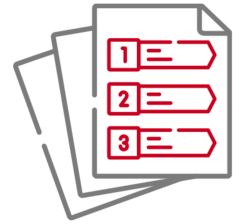verinice for everyone, everywhere
The simple way to an ISMS tool is the single-user version
With verinice Standalone you can work independently and, if necessary, offline
From 2025 on, the new verinice.veo will be available with support for all previous domains: data protection, NIS 2, BSI IT-Grundschutz and ISO 27001, as well as TISAX/VDA-ISA and BCM according to BSI 200-4 and ISO 22301. The new verinice is operated in the browser with all the advantages and disadvantages: among other things, program installation is no longer necessary – but offline operation is no longer possible.
Further advantages
- quick installation and immediate use
- no database knowledge required
- can be used offline
- simple and robust data backup
- can also be used via a terminal for small teams
- easy to upgrade to server operation with verinice.PRO
You want to get started right away? verinice is available in two uncomplicated versions in the verinice.SHOP:
- verinice Standalone: The full version as a subscription with a term of 1-3 years.
- verinice.EVAL: The light version without import and export functions for an unlimited, free trial.
In addition, the verinice.SHOP is the source for the numerous verinice add-on modules, both free and paid.
You can get support for verinice in two ways: You can either purchase support budgets in the verinice.SHOP or contact verinice sales for a support contract.

Recommended:
- RAM: 4 GB
- hard disk
- Standalone operating mode: 4 GB (free space available)
- Server operating mode: 2 GB
Minimum:
- RAM: 1 GB
- Hard disk
- Operating mode standalone: 1 GB
- Operating mode server: 1 GB

Microsoft Windows
Officially supported versions:
- Windows 10 (64 bit only)
- Windows 11
- Attention: Windows 7 is no longer supported as of version 1.20.
verinice can also be run on other versions of Microsoft Windows. However, SerNet does not test verinice on these versions.
macOS
Officially supported versions:
- macOS 13 (Ventura)
- macOS 14 (Sonoma)
- macOS 15 (Sequoia)
verinice can also be run on other versions of macOS. However, SerNet does not test verinice with these versions. On Apple Silicon processors, verinice runs from version 1.23 with Rosetta emulation.
Linux
Officially supported distributions and versions:
- Ubuntu 18.04.x LTS
- Ubuntu 20.04.x LTS
- Ubuntu 22.04.x LTS
- CentOS 7.x, 8.x
- Red Hat Enterprise Linux 7.x, 8.x
verinice can also be run on other distributions or versions of Linux, in particular CentOS. However, SerNet does not test verinice intensively on these versions.
Java Runtime Environment (JRE)
The verinice client and vDesigner only work together with a Java Runtime Environment (JRE). The verinice client is delivered together with JRE 11.
In standalone mode, the verinice client stores all data in a local database that is delivered with the client. The database used is Apache Derby. It is not possible to use a different database on the client. In server mode, no database is used on the client.
Das verinice-Webfrontend unterstützt folgende Browser:
- Google Chrome ab Version 48
- Mozilla Firefox ab Version 45
- Microsoft Internet Explorer 11
- Microsoft Edge
- Apple Safari ab Version 10
Das Webfrontend ist auch auf anderen Browsern lauffähig. SerNet testet verinice jedoch nicht mit diesen Browsern.
This page describes how to update verinice clients.
Buy verinice
You can buy verinice directly in the verinice.SHOP: You establish a shop account and buy the software in the current version. At Instant Downloads, you are entitled to download and install the software.
As soon as a new verinice version is available, you will be notified by the software itself. The latest verinice version is always available for download during the entire subscription period.
Get an update
To buy the new verinice version, you again enter the verinice.SHOP. Please be advised: After procurement of the new version, you should not download and install it over the old one. Instead, use the built-in update mechanism of the already installed version. Please also note that an automatic update within verinice is only possible from the immediate predecessor release of the current version.
To update your installed version, verinice asks you for username and password. This information is also available in the shop at Instant Downloads directly next to the procured product:
- The username is a long text code similar to this: "vn114-m64-36-nQKuE...."
- The password is always the same: "verinice"
If you encounter problems during updates, do not hesitate to contact us via mail at sales@sernet.com.
Back-up your verinice
Please ensure that you back-up your data before the update: either by means of the export function of verinice or by creating a back-up copy of the verinice workspace. If you did not make an adjustment for the -data setting using the verinice.ini (found in the verinice installation directory), the work directory (the directory "verinice") is created in the user directory by default.
Checking the Release Notes
Please read the release notes of all newer versions before updating. If required, they contain information to be considered during the update.
Manual update from a former version:
Prerequisite
verinice is installed on your computer, e.g. version 1.17 in the folder: C:\Programme\verinice-1.17
Download the zip archive with the current version from the verinice.SHOP (the latest verinice version is always available for download during the entire subscription period) or from your verinice.PRO server. Unpack the zip archive in any folder, e.g: C:\Programs\verinice
Copy settings from previous versions
Open the file verinice.ini from the installation folder of verinice 1.17 with a text editor. In our example, the path is C:\Programs\verinice-1.17\verinice.ini.
Open the file verinice.ini from the installation folder of verinice with a text editor. In our example, the path of the file is: C:\Programs\verinice\verinice.ini.
In both files you will find a line-data. This one and the next line for example look like this:
-data @user.home/verinice/workspace
Compare these lines in the two files. If the lines are identical, you don't have to do anything. If the lines are not the same, then copy the lines from the verinice 1.17 file to the current version's file. Then save the modified file.
Starting verinice
You can now start verinice by double-clicking on verinice.exe. In our example, the path is:C:\Programs\verinice\verinice.exe. The settings and data from the old version will be imported.
Problems with your update?
Please feel free to contact us – we're here to help you!


